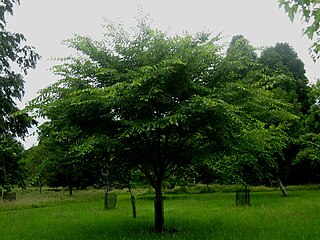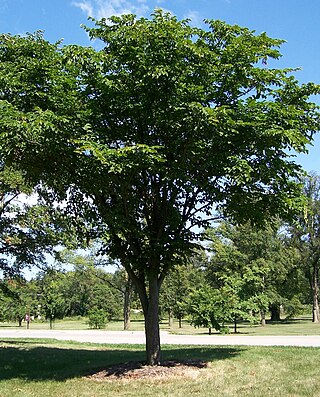
Ulmus davidiana var. japonica, the Japanese elm, is one of the larger and more graceful Asiatic elms, endemic to much of continental northeast Asia and Japan, where it grows in swamp forest on young alluvial soils, although much of this habitat has now been lost to intensive rice cultivation.

Ulmus davidiana, also known as the David elm, or Father David elm, is a small deciduous tree widely distributed across China, Mongolia, Korea, Siberia, and Japan, where it is found in wetlands along streams at elevations of 2000–2300 m (6,500–7,500 ft). The tree was first described in 1873 from the hills north of Beijing, China.
Ulmus pseudopropinquaWang & Li, occasionally known in the United States as the Harbin spring elm, is a small deciduous tree found only in Heilongjiang, the northeasternmost province in China. The tree has not been studied comprehensively, and it has been speculated it may be a natural hybrid of Ulmus davidiana var. japonica and Ulmus macrocarpa.
The American Elm cultivar Ulmus americana 'Exhibition' is a selection made by the Patmore Nurseries from seeds of a tree at Brandon, Manitoba. Released in 1952, 'Exhibition' was propagated by grafting.
The Japanese Elm cultivar Ulmus davidianavar.japonica 'Mitsui Centennial' is a cold-resistant selection raised at the Morden Experimental Station, Manitoba, Canada, in the 1970s.

The American elm cultivar Ulmus americana 'Aurea' was cloned from a tree discovered by F. L. Temple in Vermont at the end of the 19th century.
The American Elm cultivar Ulmus americana 'Fiorei' was raised by the Charles Fiore Nurseries, Prairie View, Illinois, before 1949, and first listed as 'Fiorii', Fiore Elm, without description. It is no longer listed by the company.
The American Elm cultivar Ulmus americana 'Kimley' was cloned c.1957 by the Sheridan Nurseries, Mississauga, Canada, from a large tree found near Oshawa, Ontario, Canada.
The American Elm cultivar Ulmus americana 'Morden' was cloned from a selection made by the Dominion Experimental Farm, Morden, Manitoba, in 1939 on account of its ability to withstand severe ice storms without breakage.

Ulmus laciniata var. nikkoensisRehder, the Nikko elm, was discovered as a seedling near Lake Chūzenji, near Nikkō, Japan, and obtained by the Arnold Arboretum in 1905. The taxonomy of the tree remains a matter of contention, and has been considered possibly a hybrid of U. laciniata and U. davidiana var. japonica. However, in crossability experiments at the Arnold Arboretum in the 1970s, U. laciniata, a protogynous species, was found to be incompatible with U. davidiana var. japonica, which is protandrous.
The Japanese Elm cultivar Ulmus davidianavar.japonica 'Reperta' was a University of Wisconsin–Madison selection named and registered in Germany by Conrad-Appel, Darmstadt, in 1993.
The American Elm cultivar Ulmus americana 'Flick's Spreader' was cloned from a tree discovered by John T. Flick on a farm near Hammon, Oklahoma. Cuttings were given to the Sunshine Nursery, Clinton, Oklahoma, in 1997, which later marketed the tree as 'Flick's Spreader'.
Ulmus×mesocarpaM. Kim & S. Lee is a natural hybrid elm which is a cross of Ulmus macrocarpa with Japanese elm Ulmus davidiana var. japonica discovered on Seoraksan near the city of Sokcho on the eastern coast of South Korea. The tree is endemic to the provinces of Gangwon-do, Injegun, Bukmyeon, Yongdaeri, and Baekdamsa.
The American Elm cultivar Ulmus americana 'Creole Queen' was cloned from a tree growing outside New Orleans and was released in 2008.
Phyllonorycter bicinctella is a moth of the family Gracillariidae. It is known from Hokkaido island of Japan and the Russian Far East.
Phyllonorycter laciniatae is a moth of the family Gracillariidae. It is known from Hokkaidō island of Japan and from the Russian Far East.
Caloptilia ulmi is a moth of the family Gracillariidae. It is known from China, Japan and the Russian Far East.
The Japanese Elm cultivar Ulmus davidianavar.japonica 'Validation' is a selection made by Kunso Kim and Bethany Brown of the Morton Arboretum released in 2011; propagation is by grafting onto Siberian Elm Ulmus pumila rootstocks.
The American Elm cultivar Ulmus americana 'Miller Park' is a selection made by the University of Minnesota. Originally identified as MNT-0365, it was cloned from an old elm surviving in Hennepin County, Minnesota. 'Miller Park' is currently (2016) being researched but no data have yet been published. The tree is named for the eponymous park in Eden Prairie, in the environs of Minneapolis.
The hybrid elm Ulmus davidianavar.japonica × U. minor was raised at the Arnold Arboretum before 1924.



